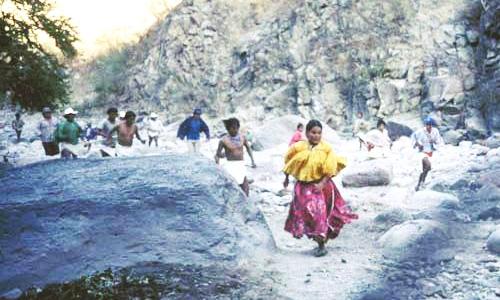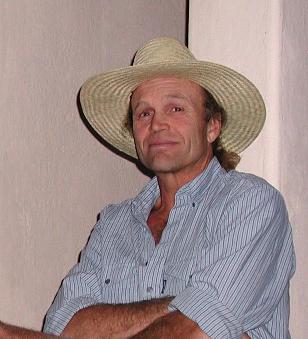Born to Run, but Christopher McDougall, spent over three months on the NY Times best seller list last year. And, no, it’s not about Bruce Springsteen. But then, if you’re a runner or endurance athlete, you’ve probably already know that. McDougall’s story of the greatest race you never heard of has already passed into cult status among the long distance literati.
I spent the past two days driving from Tacoma to Aspen, listening to this book non-stop. I suspect it’s a page-turner even if you don’t have wide open spaces boring into you, numbing your brain into seeking any stimulus to distract you from the monotony of the long-distance drive. McDougall weaves five distinct stories into a romantic idyll of a lost Mexican tribe, quirky ultra-distance runners, the scientific basis behind our ability to run seemingly forever, his own search for injury free exercise, and an ephemeral gringo expatriate lost in the wilds of Chihuahua’s Copper Canyon, Caballo Blanco, the White Horse.
By itself, each of these threads is a fascinating journey. Together, they build a seamless backdrop for the book’s climax, a 50 mile race through the canyons. It’s hard to tell whether McDougall meant to write a travelogue, a memoir, an anthropologic study, a scientific review, or a gripping sports drama. Born to Run is all of these things, and more.
The Tarahumara Indians of north central Mexico have lived in the impossibly deep and steep Copper Canyon region, driven there by the conquistadors who wanted to enslave them as miners. The area is nearly impenetrable, making it basically lawless, a home for drug runners as well as the peaceful, communitarian Tarahumara. Getting there from the USA involves a four bus two day ramble to the canyon rim, and then either a walk 8000 feet down, or a risky venture in a 4WD pickup down 20% grades, past steel carcasses of vehicles which were not so lucky.
The Tarahumara have maintained a way of life which depends not only on living from and with the land, but also on ambulation, walking and jogging, for locomotion. Like the Kenyan runners who so dominate marathon races, the Tarahumara run for pleasure, shoeless, from birth. Their main recreation, apart from binge-drinking corn beer, is racing each other for pride of place.
For a few years in the 90s, they raced in the Leadville 100, a 100 mile trail run at 10,000’ altitude, gracefully gliding by all the other racers in their thonged sandals and flowing white capes. This sparked a legend about their running prowess, which only grew when they refused to return after feeling they were being used by greedy white promoters, who seemed to want them in the same way the conquistadors did.
McDougall, 6’4”, 230#, is obsessed with running, even though he can only go 2-3 miles a day before getting debilitating foot, leg and back pains. As he looks for answers to the pain, he discovers the Tarahumara. He travels to Mexico, into the Copper Canyon district.
The Tarahumara built their society from the ground up on the basis of distrust of all outsiders, and complete trust among themselves. Very few non-tribal members from Mexico are able to talk with them, much less be accepted into their land. Caballo Blanco, an American going by the name of Micha True, had dropped out of his meagre Boulder, Co. life 10 years earlier, and was now living, and running down in the canyons, meeting the indians and gaining their trust.
He provides McDougall with the first of a cavalcade of characters, each unique and drawn with both respect and humor. Caballo wants to put on a race between the Tarahumara and the best American (“Western”) ultra-distance runners. He has a few problems getting this off the ground. For one thing, the only access he has to the outside world is a dial up modem connection at an elementary school thirty miles away from his mud-and-grass hut. And when he does send off emails, seeking sponsors and participants, he seems exactly like what he is, a more than slightly odd goofball who is probably dangerously off-kilter and unreliable.
He tries to enlist McDougall into his scheme, and after Caballo Blanco shows the lumbering “oso” how to run more like a deer, McDougall returns to the states, still seeking running nirvana. But fate intervenes, in the form of Scott Jurek, a Seattle based ultra-distance runner, 7 time winner of the Western States 100, the Badwater (Death Valley) 135 miler, and other obscure forms of self-torture. Jurek is a legend among the small long-distance running community, and McDougall ends up interviewing him for an article he’s writing. Somehow, this sparks the eventual race into being.
Along the way to the start line, McDougall gets a chance to meet or hear about a number of unforgettable people. There is the Pescador, Rick Fisher, a conniving self-promoter who brings the Tarahumara to Leadville and is the direct cause of them never returning. Ann Trason, a biologist turned super runner, who proved that women can run as fast as men at these impossible distances. Joe Vigil, track coach at Alamosa State in Co, who believes the Tarahumara have the secret to running success for all of us. Barefoot Ted, who has shucked his shoes and lives in a circus tent, but nonetheless can run with the best. Jen Shelton and her buddy, Billy the Bonehead, who at age 21, can not only run with men and women far more experienced, but beat the pants off them while suffering a hangover. Oh, and she’s a Dharma Bum, too, a follower of Allen Ginsberg and Jack Kerouac.
Each of these characters, and more, is drawn with the depth and wonder that the best fiction provides. They bring laughter, tears, primal screams, odd tattoos and laborious training regimens along with them, but emerge as people you’d really want to spend a lot of time with.
Into this barreling story of getting a bunch of oddball American runners down to the Canyons, and then racing the locals, McDougall reports on his quest to discover the true nature of running, and how it helped man evolve from a knuckle-dragging monkey to the Master of his Universe. Many runners who picked up on this book have focused on these “revelations”, preaching the value of running barefoot, the role of running in directing human evolution, and the belief that all of us are genetically programmed to be long-distance runners.
McDougall makes a compelling case, which I’m sure reassures those folks who have become obsessed with their running, allowing them to see themselves as noble princes in man’s quest for perfection. And his jihad against running shoes and the corporate marketing machines which have built a $60,000,000,000 business out of a spurious need for support while we run has sent many runners barefoot into the park. While it’s all very interesting, the story of the runners, the Tarahumara, and the race can stand alone as a beautiful sports drama, just as a capable of bringing tears to one’s heart as the science can bring facts to one’s head.
As a triathlete, two things struck me about McDougall’s book. First, the “Copper Canyon Ultra Marathon” shares a lot of characteristics with the Hawaiian Ironman: 6-12 hours for the first-time participants; performed in a distant hot and humid setting. Second, this is basically a book-length version of Barry McDermott’s seminal 1979 Sports Illustrated article on the second running of the Ironman. It describes a version of racing which quickly disappears once promoters and corporate sponsors become involved, an Eden we’d all like to get back to, and wish we had been present for in the first place.
You don’t have to be a runner, a triathlete, or even a sports junkie to love this story. But if you do fancy yourself an athlete, then you’ll be forever grateful to Christopher McDougall for falling into this plot and amongst these people, and having the chops to return and tell us all about it.


